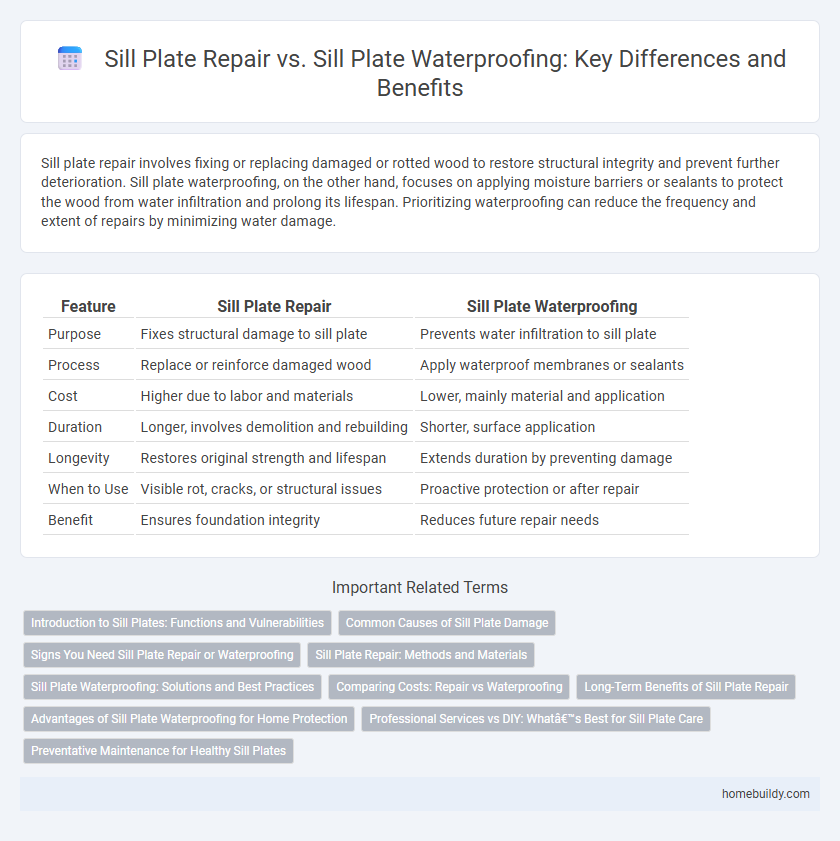Sill plate repair involves fixing or replacing damaged or rotted wood to restore structural integrity and prevent further deterioration. Sill plate waterproofing, on the other hand, focuses on applying moisture barriers or sealants to protect the wood from water infiltration and prolong its lifespan. Prioritizing waterproofing can reduce the frequency and extent of repairs by minimizing water damage.
Table of Comparison
| Feature | Sill Plate Repair | Sill Plate Waterproofing |
|---|---|---|
| Purpose | Fixes structural damage to sill plate | Prevents water infiltration to sill plate |
| Process | Replace or reinforce damaged wood | Apply waterproof membranes or sealants |
| Cost | Higher due to labor and materials | Lower, mainly material and application |
| Duration | Longer, involves demolition and rebuilding | Shorter, surface application |
| Longevity | Restores original strength and lifespan | Extends duration by preventing damage |
| When to Use | Visible rot, cracks, or structural issues | Proactive protection or after repair |
| Benefit | Ensures foundation integrity | Reduces future repair needs |
Introduction to Sill Plates: Functions and Vulnerabilities
Sill plates serve as the foundational wood beam anchoring a building's frame to the concrete foundation, providing structural stability and load distribution. These components are highly susceptible to moisture damage, which can lead to rot, mold growth, and compromised structural integrity if left untreated. Repairing a damaged sill plate involves replacing decayed wood and restoring its load-bearing capacity, whereas sill plate waterproofing focuses on preventing moisture infiltration through sealants and barriers to extend the lifespan of the existing material.
Common Causes of Sill Plate Damage
Sill plate damage commonly arises from prolonged moisture exposure, wood rot, and termite infestation, which compromise the structural integrity of the home's foundation. Sill plate repair involves replacing or reinforcing the damaged wood to restore stability, whereas sill plate waterproofing focuses on preventing water infiltration through sealants, membranes, or drainage improvements to mitigate future damage. Understanding these causes highlights the importance of both timely repair and effective waterproofing in preserving the lifespan of sill plates.
Signs You Need Sill Plate Repair or Waterproofing
Visible rot, warping, or mold growth on the sill plate are clear signs that repair is necessary to maintain structural integrity. Water staining, dampness, or persistent moisture near the foundation indicate the need for sill plate waterproofing to prevent further damage. Cracked or loose sill plates combined with water infiltration signals both repair and waterproofing interventions are crucial.
Sill Plate Repair: Methods and Materials
Sill plate repair involves replacing or reinforcing damaged wood to restore structural integrity and prevent further decay, commonly using pressure-treated lumber or composite materials for durability. Techniques such as sistering, epoxy wood consolidation, and injecting wood hardeners effectively address rot, cracks, and insect damage. Proper repair ensures a stable foundation connection, reducing risks of moisture intrusion and enhancing overall building longevity.
Sill Plate Waterproofing: Solutions and Best Practices
Sill plate waterproofing involves applying specialized sealants or membranes to prevent moisture intrusion and protect the wood from rot, mold, and structural damage. Effective solutions include using polyurethane caulks, bituminous coatings, and installing proper drainage systems to divert water away from the foundation. Best practices recommend regular inspection, prompt sealing of cracks, and maintaining gutters and grading to enhance sill plate longevity and maintain foundation integrity.
Comparing Costs: Repair vs Waterproofing
Sill plate repair typically involves replacing rotted or damaged wood, with costs ranging from $500 to $2,500 depending on the extent of damage and labor. Sill plate waterproofing generally costs between $1,000 and $3,000, as it includes sealing, applying protective coatings, and moisture barriers to prevent future damage. While repair addresses existing problems, waterproofing acts as a preventive measure that could reduce long-term expenses associated with structural damage and mold remediation.
Long-Term Benefits of Sill Plate Repair
Sill plate repair restores structural integrity by replacing rotted or damaged wood, preventing further deterioration and costly foundation issues. This repair significantly extends the lifespan of the foundation framing, ensuring a stable and secure base for the entire building. Proper sill plate repair enhances long-term property value by maintaining the home's structural safety and reducing the risk of mold and pests associated with compromised wood.
Advantages of Sill Plate Waterproofing for Home Protection
Sill plate waterproofing creates a durable barrier that prevents moisture infiltration, significantly reducing the risk of wood rot, mold growth, and structural damage. Unlike sill plate repair, which addresses damage after it occurs, waterproofing proactively protects the foundation, extending the lifespan of the home's framing components. Effective waterproofing enhances energy efficiency by maintaining a dry basement environment and minimizing costly repairs associated with water damage.
Professional Services vs DIY: What’s Best for Sill Plate Care
Professional sill plate repair ensures structural integrity by addressing wood rot, termite damage, and foundational shifts with expert precision, often requiring specialized tools and materials. Sill plate waterproofing, while simpler, demands thorough sealing techniques and quality waterproof membranes to prevent moisture infiltration and prolong lifespan. Opting for professional services guarantees comprehensive assessment and long-term protection, whereas DIY methods may suffice for minor waterproofing but risk overlooking critical damage.
Preventative Maintenance for Healthy Sill Plates
Sill plate repair addresses existing damage such as rot, cracks, or warping, ensuring structural integrity, while sill plate waterproofing prevents moisture infiltration that causes deterioration. Preventative maintenance through waterproofing prolongs the lifespan of sill plates by creating a moisture barrier, reducing the need for costly repairs. Regular inspection combined with proper waterproofing treatment supports healthy sill plates and foundational durability in residential construction.
Sill plate repair vs Sill plate waterproofing Infographic

 homebuildy.com
homebuildy.com